#knowledge production
Text
Fandom (and art) as sites of worthless knowledge
Instead, what if we embrace fandom and art practice as a site of “worthless knowledge” (Jenkins), which is when art and fanfiction stops operating under conditions of “immaterial labour” or as “a service” and becomes something else: let’s call it an “affective knowledge”; a textural knowledge felt and sensed by individuals and communities over knowledge inscribed by institutions of power.
. . . .
Fans have spent decades harbouring shame over their exploits because “[f]ans are seen as devoting too much time to obtaining useless knowledge and place too much importance on ‘devalued cultural material.’ ” Spending excessive amounts of time reading or writing fanfictions about boy-on-boy romance, fans are not at work doing something more productive like contributing to capitalism’s productive regime. Just as when female fans are fantasising about boy-on-boy romance, they are not participating in heterosexuality’s reproductive regime. ( . . . ) As Tonya Anderson points out in her article “Still Kissing the Poster Goodnight”: “dominant cultural politics characterise such female fan behaviour in adulthood as pathological.” In such instances fans are operating in “excess” and at best – in counter-to-knowledge.
From here, art and fandom might be better understood as affective communities that form around a shared feeling, that might not only be defined by our social or biological identities or by knowledge, but by an unproductive pleasure that undermines our productive desires, or to put it simply: by “being in love with their love” (Karukara).
PARRY, OWEN G. (2019) ‘“SHIPPING” (AS) FANDOM AND ART PRACTICE’. FANDOM AS METHODOLOGY. LONDON: GOLDSMITHS PRESS.
65 notes
·
View notes
Quote
Addressing epistemic injustice involves recognizing the ways in which different forms of social identity can impact the distribution of knowledge and resources, and taking steps to ensure that everyone has equal access to knowledge and is treated with equal respect and consideration. It requires challenging the structural inequalities and biases that contribute to these forms of injustice, and working to create more inclusive and equitable systems of education, knowledge production, and cultural representation.
Pranav Jeevan, ‘Epistemic Injustice: Does Knowledge have Caste?’, Round Table India
#Round Table India#India#Pranav Jeevan#epistemic injustice#social identity#distribution of knowledge and resources#structural inequalities and biases#injustice#education#knowledge production#cultural representation
4 notes
·
View notes
Text
i feel like yesterdays travel writers are todays academics...so in a way academics are also imperialists.
#in this paper i will#discuss the ways in which academics (re)write and appropriate histories to further stabilize colonial forms of story telling and#knowledge production
3 notes
·
View notes
Text
WDM PRODUCTION OF KNOWLEDGE
WDM EDITORIAL
Most of us share or reproduce other people’s knowledge or experiences. Most of us don’t try to produce original ideas based on observations or personal experiments. The most obvious sources of these reproductions of other people’s staff is the internet, especially the social media. We are made constantly busy in browsing information from our social contacts. We have little time…
View On WordPress
0 notes
Text
everyone makes fun of soap when they find out how many hair and skin products he keeps on hand. the cabinet in his bathroom is filled to bursting and he always keeps travel sized bottles on him on missions
when soldiers outside the 141 find out, they call him precious and self-obsessed, a vain pretty boy too preoccupied with his reflection to focus on the enemy. no wonder how he got his callsign. price has given up telling him to leave them on base and just teaches him to individually wrap them so they don’t rattle against each other and give himself away
what they don’t know is that each product contains an ingredient that when mixed with any number of the others, creates potent chemical bombs. he was caught unarmed once, he won’t let it happen again
#ghost picks it up when he watches him meticulously read the ingredients lists on the bottles when he goes shopping with him once#he knows enough about products to know that when you find one that works you keep using it#so hes confused when he sees soap put back a moisturiser hes certain hes seen in his little bag#he waits for him to leave the aisle and checks the bottle#which is when he sees the new and improved formula sticker on the back#he memorises the ingredients and when he checks the bottle in soaps room sure enough theres an ingredient missing#thats when he puts it together#it seems his little intro into guerrilla warfare had sparked some ideas in his sergeant#and hes so damn proud it takes him off guard for a second#he hadnt expected him to keep up with it not when hed rarely need the knowledge#but he is and hes doing it all on his own using his own expertise and forethought#the pride has to make room for a difference kind of warmth at the sheer competency on display in front of him#the next day he drops a new product with the missing ingredient on soaps head#the soldiers around them are shocked that hed indulge in soaps prissiness#hes the only that that sees the feral glint in soaps eye as he thanks him and starts going on about the benefits of looking after your skin#coming out of my cage and ive been doing just fine.txt#ghost x soap#soapghost#ghostsoap#ghost mw2#cod ghost#cod soap#soap mw2#soap mactavish#cod mwii#call of duty#we’re a team. ghost team
5K notes
·
View notes
Text
I saw this whole long thread of people hand-wringing about "anti-intellectuals" on tiktok and how scary it is that they're believing sourceless claims other people on tiktok tell them, because they claim they have the same chance of being correct as anything that "science says."
and said hand-wringers were waxing poetic about the scientific method and replicability and how everything that's published in an academic journal is guaranteed to be true and correct because of a little thing called peer review whereby scientists (naturally a petty and pedantic people) are encouraged to tear each other's conclusions apart.
and I just have to say. if you believe (in the midst of a major replicability crisis amongst scientific journals, no less) that everything published in a scientific journal is de facto factual or trustworthy, and if you believe that peer review of all things is a process that is guaranteed to prevent papers with anything from flaws in experimental design to full-blown fraud from going to print (as if publishers don't have a literal profit motive to publish studies that yield novel, startling conclusions),
then you are 100% as "anti-intellectual," foolish, & averse to thinking for yourself as the tiktokers you're making fun of. actually I think I like you less. at least their ideas might be bizarre enough to be interesting
#while being wholly ignorant of sociology of science & the social and economic factors that go into scientific knowledge-production#is very common and boring
2K notes
·
View notes
Text
A little ghost adam doodle dump bc turnipoddity's ruining me with those comics and i dont think ive ever posted anything abt him b4



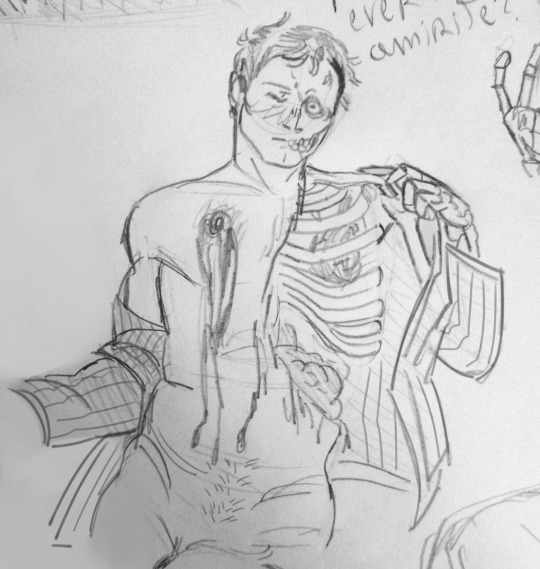
Brought to you by a doofus who knows jack shit about drawing skeletons. Heh get a load of all them anatomical inaccuracies for the sake of looking cool
#is he real? is he but a product of Lawrence's guilty conscience combined with a doctor's knowledge of what rotting dead bodies look like?#who knows...#all i know is he often stands by the foot of Lawrence's bed at night to stare at him and say smth dumb every once in a while#saw#saw movies#saw franchise#saw fanart#adam faulkner stanheight#adam faulkner#adam stanheight#saw adam#latenightsundayblues art tag#tw gore
622 notes
·
View notes
Text
i don't understand how college survives as a gatekeeping/ financial bondage institution. do you know how many eastern european history/studies (not russian) tenure track positions are open in the united state this year? 2. there are 5 positions open for european history; for american history, 21. higher education is going to collapse within 15-20 years
#the near-peers you read online are going to be the last historians/scholars of this mode of education and knowledge production#this is a tangent to the other post#academia
326 notes
·
View notes
Photo
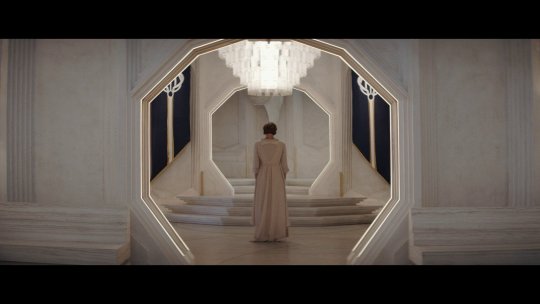
Okay, time to get pretentious and REALLY talk about this shot.
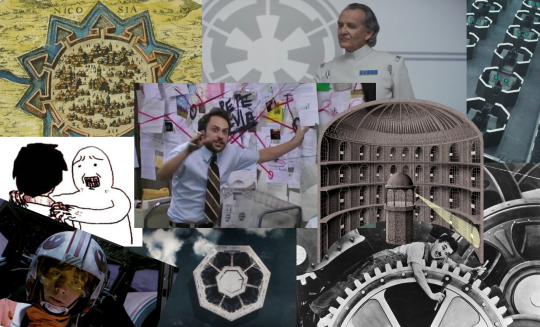
So put on your over-analysis goggles, and let’s talk about the Imperial Cog, Renaissance-era military forts, 18th century prison architecture, the military-industrial complex, the surveillance state, and why this single shot of Mon Mothma standing in a doorway in “Nobody’s Listening!” (the 9th episode of Andor season one) is making me so feral I want to kiss Luke Hull and his entire production design team right on the mouth.

For those of you not in the know - the shape on the screen behind Major Partagaz is the crest of the Galactic Empire - often called the Imperial Cog. It appears throughout Star Wars media on flags, tie fighter helmets, uniforms and as a glowing hologram outside ISB HQ.
In canon it was adapted from the crest of the Galactic Republic.
irl it was created by original trilogy costume designer John Mollo. Mollo has stated that the symbol was inspired by the shape of historical fortifications.

Bastion forts (aka star forts) first appear during the Renaissance with the advent of the cannon. Their shape eliminated blind spots, allowing for a 360 degree field of fire.
An apt metaphor for the Empire. Powerful, imposing and leaving you with nowhere to hide.
The Imperial crest also strongly resembles a gear or cog - hence the common “Imperial Cog” nickname.
Given how inextricably linked military and industry are, it’s also an apt metaphor. Both alluding to the Empire’s massive industrial power, and how it treats all of its citizens with a startling lack of humanity, valuing them only for what they are able to produce for the Empire.
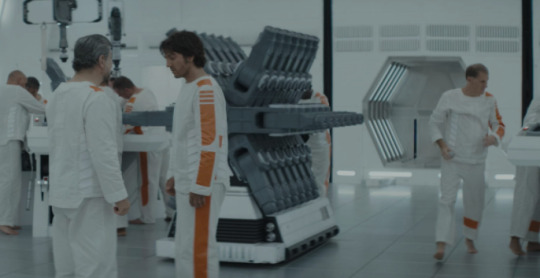
The idea of the cog is repeated in the shape of whatever it is that they’re producing in the prison. They’re literally cogs in the Imperial machine making more cogs for the machine... while inside a larger cog.

This shape, in relation to a prison, also references something else which was almost certainly intentional on the production team’s part.
In the 1791 British philosopher and social theorist Jeremy Bentham proposed a design for a prison he referred to as the “panopticon” - the name derived from the Greek word for “all seeing”.

The basic design for the panopticon was a large circular rotunda of cells with a single watchtower in the center. The plan would allow a single guard to theoretically observe every cell in the prison, but more importantly cause the prisoners to believe they are under surevillance at all times, while never being certain.
Later philosophers (notably Michel Foucault) used the panopticon as a metaphor for social control under totalitarian regimes or surveillance states. The perceived constant surveillance of a panopticon causes prisoners to self-police due to the belief they are always being watched, even if they don’t know for certain that is true. They live in constant fear even if nobody is actually watching them, even if “Nobody’s Listening!”
The idea of the metaphorical panopticon has in more recent years been adapted to many other examples of social control: CCTV, social media and business management...
Like the concept of cubicles in an open floor plan office.

So that all being established - let’s finally talk about Mon Mothma’s apartment.
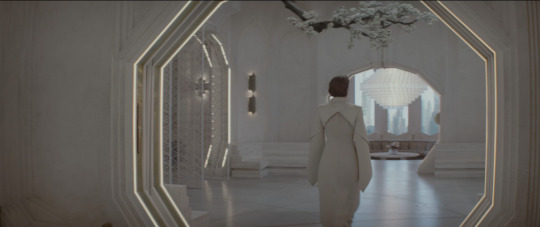
The cog shape is everywhere. There’s hardly a shot where at least one cog isn’t visible. Every room is connected by cog-shaped doorways.

The shape serves as a backdrop to most scenes, often centered and featured prominently.
(Side Note: The cog also appears as a repeated pattern on room dividers with the interesting added detail of intersecting lines that make them resemble spider webs.

The fact that Mon is often filmed directly through these web-like screens (particularly when conducting rebellion business) leads me to believe that this was a very intentional choice.
Even in the very heart of the Empire the nascent Rebellion is starting to build a web of networks and intelligence.)
I had originally presumed that the repeated appearance of the cog was just Luke Hull and his production team adding some brilliant visual storytelling to their already amazing sets. But the following line from episode ten leads me to believe they intended for these details to have an in-story explanation as well.
When speaking to Tay and Davo Skuldon about the apartment Mon states that “It’s state property. The rules are strict on decor. Our choices for change are limited.”
While it’s unclear whether the “state” in this instance is Mon’s home planet of Chandrila or the Empire itself - that second option makes the decor even more insidious.
If Mon’s apartment is Empire property that means the shape of the doors is intentional in-world, not just for the sake of visual storytelling. It means that this was a conscious decision by the Empire. A reminder to even the richest and most powerful of its citizens that they are always watching - whether you can see them or not.
Which brings us back to our original shot.

My favorite thing about this shot isn’t just that is shows how very alone Mon Mothma is.
It isn’t just that she’s in the heart of the Empire, surrounded and dwarfed - just another cog in their machine.
It isn’t just that’s she trapped in her own metaphorical prison, worrying her self sick about who may be watching, not safe even in her own home.
What makes this shot truly extraordinary to me, is that right in the midst of the Empire you can see a new symbol forming.
Forming with Mon Mothma right at the center.
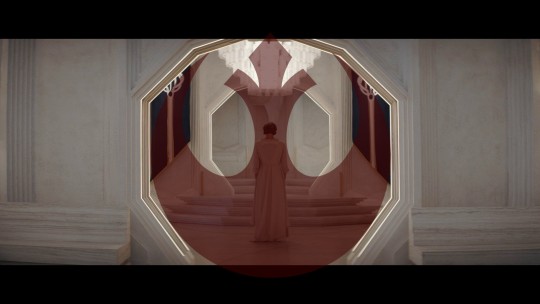
It’s a bit blocky, still constrained by the the harsh lines of the Empire, but giving how intentional every design decision on this show has been I find it pretty hard to believe it’s there by accident.
A symbol that will one day adorn the helmet of a boy from Tatooine.
One that will come to represent what all rebellions are built on...

#andor#andor spoilers#star wars#HOW IS THIS SHOW SO GOOD?#mon mothma#production design#history#long post#whose extensive knowledge of star wars and the history of the criminal justice system is useless now MOM
3K notes
·
View notes
Text

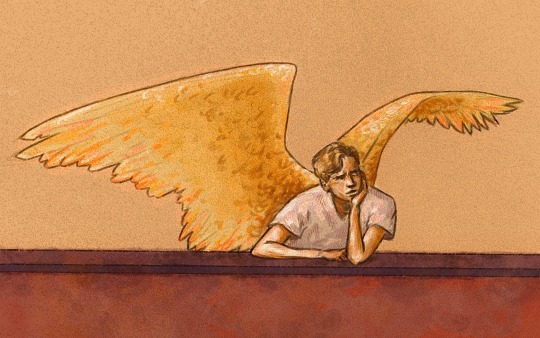
Jack Kline
#hhhhh#supernatural#rediscovering my comfort show#man its awesome#been rewatching it from the start#i‘m only at season 9 and my knowledge only reaches till season 11 but i‘m catching up fast#seen bits n pieces of jack‘s scenes but i already know i‘m gonna love him#jack kline#fanart#nephilim#wings#au#i am about to get totally yelled at but hey i was productive 😀#i was in a rly good mood like 10 seconds ago#mummenschanz#wish me luck.#spn#Alexander calvert
2K notes
·
View notes
Text
I know after every rerecording I go "wow this is so good! definitely no cause for complaints!" but like for real this time if I see anyone complaining I will be baffled because these songs sound SO similar
#i'd imagined that this would be easier to recreate#since her voice sounds pretty much the same between now and then#and it feels like this style of production would be easier to replicate since it's more digitised#compared to like trying to recreate an exact guitar twang (not that i have any music knowledge about what's actually easy)#but still i am so impressed#also props to christopher rowe whoever he is!#I'd expected him to solely fill in for the nathan chapman produced songs but to be also doing so much of 1989#is impressive given how different it is to fearless or whatever#talking#taylor swift
142 notes
·
View notes
Text
Fannish proximity across time and space
Sedgwick wrote on the transformative potential of queer reading practices in ways that, to me, also describe fannish modes of attachment:
"I think that for many of us in childhood the ability to attach intently to a few cultural objects, objects of high or popular culture or both, objects whose meaning seemed mysterious, excessive, or oblique in relation to the codes most readily available to us, became a prime resource for survival. We needed for there to be sites where the meanings didn’t line up tidily with each other, and we learned to invest those sites with fascination and with love."
In the same passage, she writes of “a visceral near-identification with the writing I cared for”: not with one or more of the characters, but with the writing; “on the level of sentence structure, metrical pattern, rhyme.” This fannish merging with the text – with its aesthetic form – was “one way of trying to appropriate what seemed the numinous and resistant power of the chosen objects.”
Meanwhile, Carolyn Dinshaw, a medieval scholar and one of the founding co-editors of the journal GLQ, was writing about the “queer ... touch across time”: the intense affective attachments, including identification, which produce queer – that is, oblique, resistant and desiring – relationships to the medieval past, which exceed and refuse normative trajectories and linear histories, and find in medieval pasts and texts that “numinous and resistant power” that makes certain art objects, for their fans, potent “resources for survival.” Finding in the distant past another way of organising sexuality, selfhood and experience, which we somehow recognise, which we somehow need – the “defiant and confused” feeling of knowing, without knowing how we know, that this book, this person, this artwork, is “one of ours,” as Alison Hennegan describes in “On Becoming a Lesbian Reader.” The queer touch across time retrieves though this is too passionless a word – it rescues artworks and archives from the dustbin of history, resonating with Taylor J. Acosta’s characterisation of fandom as “a historiographic approach in the Benjamanian tradition, not as an explicit critique of history, with its pretences to critical distance, total understanding, and specificity, but rather as an alternative practice in which an art produced of love and affect can function historically.” The queer or fannish touch across time produces “worthless knowledge”: knowledge that has no value that can be registered by neoliberal-capitalist metrics and that is for that reason invaluable.
(It strikes me that my desire to quote from these texts, to show them to you, is itself fannish. Look! Look at this thing that I love! It says something to me that cannot be said in any other form. Does it speak to you too? What does it say?)
WILLIS, I. ‘AFTERWORD: FAN THEORY/THEORY FAN OR I LOVE THIS BOOK’. FANDOM AS METHODOLOGY. LONDON: GOLDSMITHS PRESS.
18 notes
·
View notes
Photo

SEEDS of growth.
#my art#millions knives#nai#trigun#trigun stampede#tristamp#look im very emotional about him getting a second chance at life#and getting to work with SEEDS and be able to apply all his skills and knowledge in a way that is productive#and beneficial to both the world and himself#it would be so enriching to apply himself in such a way#see the fruits (haha) of his labor#i just aaaaaaaaa#so many feelings
158 notes
·
View notes
Text
i will be totally honest with y’all i can’t see Hobie (ATSV) in a romantic relationship ever. like, i can’t see him seeing anybody ever as “the one” or even having multiple partners or anything. I can barely see him having friends outside of the ones he already has. I can somewhat see the “are we dating or are we not dating” thing being something he gets involved in, but not really. i think a lot of people either don’t know or just forget that he’s probably homeless and that his world is shit rn and that stuff he needs isn’t easy to come by 😭😭 and a lot of homeless people just don’t have time/energy for shit like romantic relationships and the stuff he’s doing canonically because they’re so focused on trying to survive. That’s why when I make posts about him casually flirting or whatever it’s never serious, it never goes anywhere, because honestly! Between music shows, trying to find your next meal, fighting the power, trying to find a shelter for the night, helping other homeless people and others in need as both a civilian and Spider-Man, dealing with dimensional threats, trying to find a place to get clean, i just don’t think Hobie has time to even consider it. Sure, maybe there are facilities in the HQ to make it easier, but after that stunt, i think he’d avoid using them as much as possible. do you see what i mean??
#like i know he isn’t confirmed homeless in the movie. but like#like. i know. i also don’t like to think about homelessness and how terrifying it is esp for black guys#but you gotta realize he does not have all these damn hair products. he probably doesn’t smell good either#and he probably doesn’t have good breath most days or good teeth at all#and his clothes are probably dirty more often than not#and he will not be fun. people are not fun when their basic human rights are stripped away and they’re treated like garbage for a majority+#of their life#like. i genuinely think people just don’t consider a lot of shit he doesn’t do or even get the chance to bc he’s homeless#and how you’re treated like a pest and as if you aren’t human and don’t deserve human decency/necessities#now don’t get me wrong. i love to imagine hobie having a reliable space at the commune! with karl and kamala and all them. but +#that doesn’t mean he has reliable food sources and it’s basically a middle class well stocked and cared for house#of course i can’t/won’t police you because i don’t give a shit about what others do regarding him but yknow. keep it in mind at least#don’t even get me started on the knowledge of fixing pipes and other broken shit. god i could go on forever lol#this post was about Hobie not dating anybody and it turned into this 10/10 to myself actually#hobie brown#spiderpunk#spider punk#m&m posts
121 notes
·
View notes
Photo
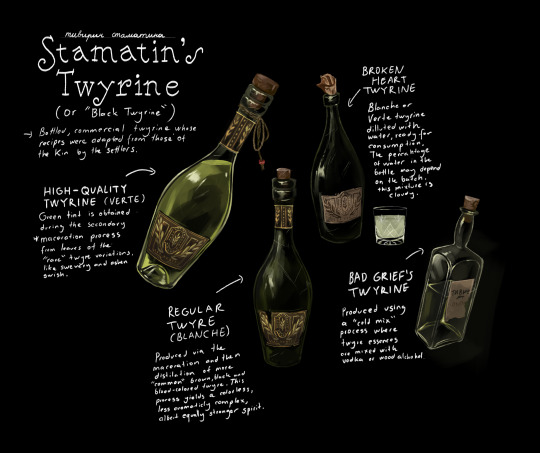
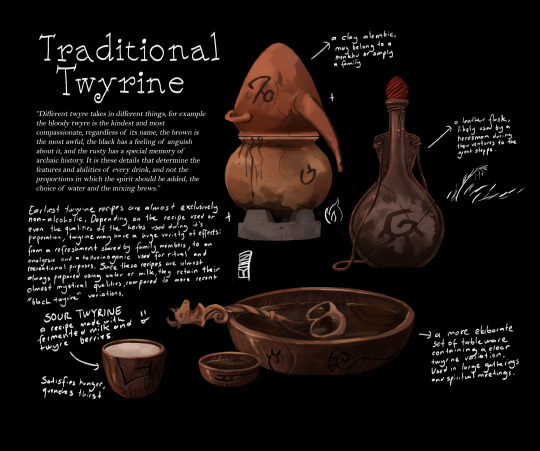
twyrine studies
(first posted 18/08/2021)
#absinth but cooler#pardon my poor alcohol production knowledge i just wanted to paint cool glass#pathologic#pathologic 2#twyrine#andrey stamatin#twyre
1K notes
·
View notes
Note
I have a question that I don't know the answer to. And I'm not sure if there's already an answer to this or not.
Why is Wally the only neighbor with no noes and no eyebrows? Was that like a way to make Wally seem like an outcast or something??
It droved me crazy with confusion the first time I realized this.......
And PLEASE don't see this as an ask of me "JUST noticing now". I noticed a month ago (ever sense I first started loving Welcome Home as a hyperfixation) but I kept it to myself because I was too embarrassed to ask to really know. And it's really ok if you don't know either.
oh yeah no to my knowledge we don't know why that's a Design Choice That Exists! could be to make him look a little more unsettling than the others (more out of place within his own niche to kinda mirror how he's Different despite filling the role he's made for & existing in the place he Should Be In) bc this is a Horror project, or just because no nose/eyebrows looked best on him-
but it might be something we're not In On yet! lore we haven't learned! we just don't know
#hey it could even be Main Character Disease#like how anime main characters tend to have the wild designs & colorful hair#but i doubt that's what it is lmao i mainly said that as a joke#but i Suspect it's just a design choice to be like 'hey hes kinda fucked up huh.' to assist in his Creepyness#though i would not be shocked if there's a story reason for it#like if his creator (dorelaine?) had a specific reason not to include eyes/eyebrows#or maybe the creator like... idk died or somethin before they could finish wally#which actually. hm. ok new theory#what if wally was Unfinished... given that the show did exist or at least was in production of course#but that could be why he's missing some facial features and lacks a 'pre-implanted' memory / knowledge about living#and why he's so obsessed with fulfilling his role... he was never given anything else...#JUST A THOUGHT! a delusional theory to chew on#homebogging#welcome home speculation#wh speculation#wally remains an Enigma!#and oh hey it could be to mimic Home???#Home doesn't have eyebrows or a nose#which actually that makes me think about a slight correlation between the rigidity of Home's door/features#and the rigidity of wally's smile...#no im being insane again. OR AM I!#no i am i am... or am i...
60 notes
·
View notes